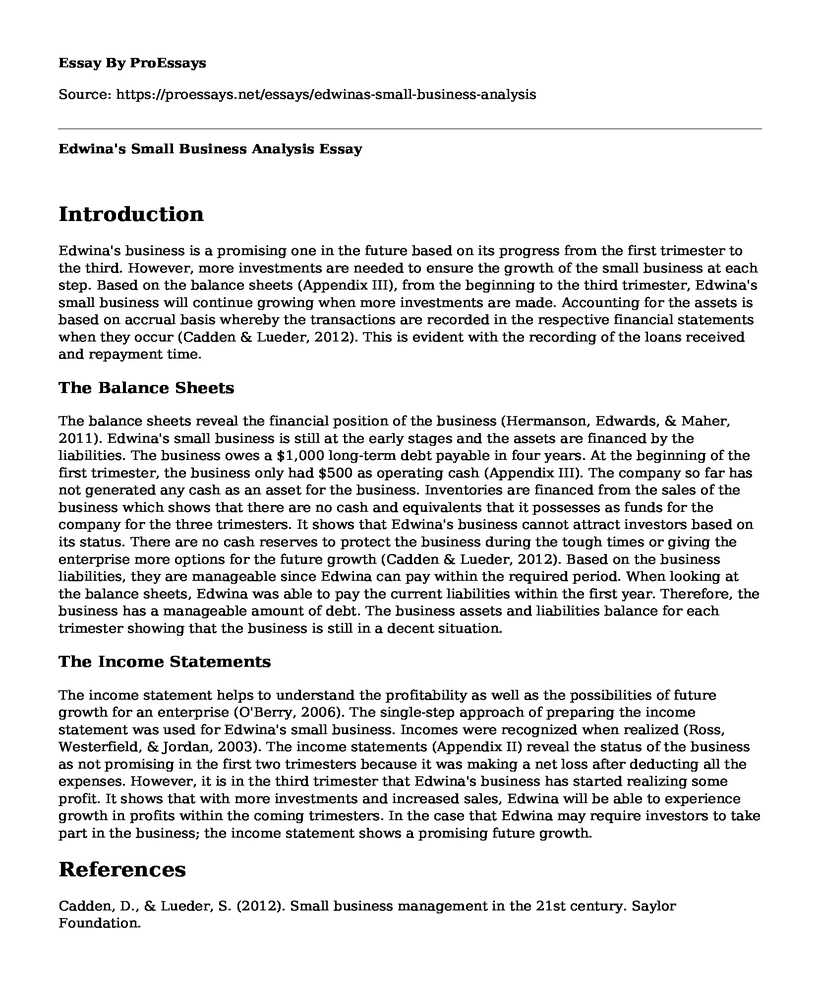Introduction
Edwina's business is a promising one in the future based on its progress from the first trimester to the third. However, more investments are needed to ensure the growth of the small business at each step. Based on the balance sheets (Appendix III), from the beginning to the third trimester, Edwina's small business will continue growing when more investments are made. Accounting for the assets is based on accrual basis whereby the transactions are recorded in the respective financial statements when they occur (Cadden & Lueder, 2012). This is evident with the recording of the loans received and repayment time.
The Balance Sheets
The balance sheets reveal the financial position of the business (Hermanson, Edwards, & Maher, 2011). Edwina's small business is still at the early stages and the assets are financed by the liabilities. The business owes a $1,000 long-term debt payable in four years. At the beginning of the first trimester, the business only had $500 as operating cash (Appendix III). The company so far has not generated any cash as an asset for the business. Inventories are financed from the sales of the business which shows that there are no cash and equivalents that it possesses as funds for the company for the three trimesters. It shows that Edwina's business cannot attract investors based on its status. There are no cash reserves to protect the business during the tough times or giving the enterprise more options for the future growth (Cadden & Lueder, 2012). Based on the business liabilities, they are manageable since Edwina can pay within the required period. When looking at the balance sheets, Edwina was able to pay the current liabilities within the first year. Therefore, the business has a manageable amount of debt. The business assets and liabilities balance for each trimester showing that the business is still in a decent situation.
The Income Statements
The income statement helps to understand the profitability as well as the possibilities of future growth for an enterprise (O'Berry, 2006). The single-step approach of preparing the income statement was used for Edwina's small business. Incomes were recognized when realized (Ross, Westerfield, & Jordan, 2003). The income statements (Appendix II) reveal the status of the business as not promising in the first two trimesters because it was making a net loss after deducting all the expenses. However, it is in the third trimester that Edwina's business has started realizing some profit. It shows that with more investments and increased sales, Edwina will be able to experience growth in profits within the coming trimesters. In the case that Edwina may require investors to take part in the business; the income statement shows a promising future growth.
References
Cadden, D., & Lueder, S. (2012). Small business management in the 21st century. Saylor Foundation.
Hermanson, R., Edwards, J., and Maher, M. (2011). Accounting principles: A business perspective. Financial Accounting (Chapters 1 - 8). A Textbook Equity Open College Textbook. Retrieved from https://www.saylor.org/site/wp-content/uploads/2011/11/BUS103-TEXTBOOK.pdf
O'Berry, D. (2006). Small business cash flow: Strategies for making your business a financial success. 1st Edition. Wiley.
Ross, S., Westerfield, R., & Jordan, B. (2003). Fundamentals of Corporate Finance, Sixth Edition, Alternate Edition. Volume 1. The McGraw.
Cite this page
Edwina's Small Business Analysis. (2022, Jun 06). Retrieved from https://proessays.net/essays/edwinas-small-business-analysis
If you are the original author of this essay and no longer wish to have it published on the ProEssays website, please click below to request its removal:
- Two Investment Projects Analysis
- Food Service Industry
- Problem Solving Example on Finance and Investments
- DBA: Forms of Business Ownership Essay
- Financial Statements Analysis of Fitbit Inc Paper Example
- Paper Example on Perceived Value: Crucial for Sustaining Restaurants in Fierce Competition
- Essay Example on 5 Yrs of Law Firm Qualifications: A Critical Look at Old Job Descriptions







